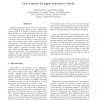91 search results - page 1 / 19 » Underwater Robotics |
ICRA
2000
IEEE
13 years 9 months ago
2000
IEEE
The development of two new classes of commercial underwater robotic vehicles – deep diving work-class remotely operated vehicles and survey-class autonomous vehicles – is bein...
CRV
2006
IEEE
13 years 8 months ago
2006
IEEE
Abstract This paper provides details on the development of a tool to aid in 3D coral reef mapping designed to be operated by a single diver and later integrated into an autonomous ...
IROS
2008
IEEE
13 years 11 months ago
2008
IEEE
— Underwater operations present unique challenges and opportunities for robotic applications. These can be attributed in part to limited sensing capabilities, and to locomotion b...
ICRA
2008
IEEE
13 years 11 months ago
2008
IEEE
— GPS-free localization is essential for navigation and information tagging in small robotic fish-based aquatic mobile sensor networks. Constraints on size, weight, and onboard ...
ICAS
2009
IEEE
13 years 8 months ago
2009
IEEE
Legged autonomous vehicles move by executing patterns of leg-joint angles known as gaits. Synthesizing gaits by hand is a complex and time-consuming task which becomes even more c...

